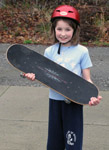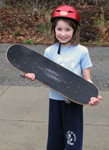The Kids' Science Challenge Winners Announced

The Kids’ Science Challenge is a nationwide annual competition for 3rd to 6th graders to submit experiments and problems for a select group of scientists and engineers to solve. The winning students, chosen from 770 entries, will collaborate with scientists and engineers to see their ideas come alive. This is the first year of the Kids’ Science Challenge, funded by the National Science Foundation and created by Jim Metzner, the award winning radio producer of Pulse of the Planet, to encourage elementary school students to discover that science is cool.

“We were extraordinarily lucky to have a great group of scientists working in areas that immediately appealed to kids. We were impressed by the caliber of the entries and the scientists are really excited about collaborating with the winning students to work on the questions and challenges they’ve raised. The Kids’ Science Challenge encourages teamwork and thinking outside the box. The exciting part of this project is just starting. Now the kids and scientists will get to work to make the kids’ ideas come alive,” exclaimed Metzner. And the winning students are:
Lindsay Carnes (shown above)
5th Grader
Our L ady of Mercy School
Lewisville, NC
Lindsay will be working with the skateboarders to see what would happen if you used balls for the wheels like on a Dyson vacuum. Skateboard engineer Michael Bream says “I've never seen anything quite like it in skateboarding before. There are several aspects that would need to be tested, including the size, position and composition of the ball. One of the main reasons we decided on Lindsay’s idea is that it's one that would yield a lot of experimentation to get right, and both Paul Schmitt and I believe that this could actually result in a viable product.”
Claire Dworsky
3rd Grader
Lycée Francais La Perouse
San Francisco, CA
Claire’s question for the water specialist is “Can we test different stages of the water cycle runoff from grass and turf fields to see if one is more toxic than the other and if they could hurt plants, people, animals or ocean life?” Scientist Adina Paytan was impressed that Claire’s challenge was based on observations of the environment and posing questions that stem from these observations. Explained Dr. Paytan, “I will be working with Claire to design the experiments that will answer the questions she posed. Claire will collect runoff from various fields and analyze this water for pollutants. We will also try to get information from the city about the frequency of watering the fields and the use of fertilizers and pesticides to maintain the fields.”
Team Candy Doctors:
Devin Claire Hollinger, Ian Michael Williams and Anna Xystros, 5th Graders
Cape Henry Collegiate School
Virginia Beach, VA
Team Candy Doctors want to see if they can make a candy tongue depressor that will taste good, smell delicious and not make you gag when the doctor tells you to ‘Say Ahhhh.’ Flavorist Joan Harvey felt the students were creative in replacing an experience they don’t enjoy with one that would be more pleasurable. She’ll help the students to create the candy tongue depressor, which might even help soothe your throat!
Tools and ideas to transform education. Sign up below.
Kamau Hamilton
6th Grader
Central Harlem Montessori School
New York, NY
Kamau’s question for the SETI team is “how can we communicate with extraterrestrials if we don’t know if they have a language similar to ours and if we don’t know their communication system?” A common phenomenon on Earth and other planets would be the sound of the physical environment. Should we send sounds from the earth, like rain, storms, lightning, or the ocean? The SETI Institute scientists will work with Kamau on recording, collecting and putting together a list of sounds he would like to include in a message to extraterrestrials. While at the SETI Institute, he will meet with scientists to discuss the “Sounds of Earth” that were included on NASA’s Voyager spacecraft that launched in 1977 and think about new sounds we might include that didn’t exist 30 years ago. Kamau and the team of scientists will put together a CD of his own “Sounds of Earth” that will be available on the SETI Institute’s website.
Participating scientists and engineers for the first year challenge, which launched October 1, 2008 include:
? Michael Bream, founder, Gravity Skateboards and Paul Schmitt, founder, CreateAskate.org, who are engineering safe, new skateboard designs
? Adina Paytan, Associate Research Scientist, Institute of Marine Sciences, University of California, Santa Cruz, who tracks pollution through a worldwide network of oceans, rivers, and underground waterways
? Joan Harvey, Flavor Development Manager at Cadbury, who is creating new flavors for candy
? Jill Tarter, Doug Vakoch, Nathalie Cabrol and Seth Shostak, members of the SETI team, who are involved in the challenges of searching for extra-terrestrial life in the universe
"The Kids’ Science Challenge offers an innovative model that lets children pose research questions and suggest experiments to be conducted by real scientists and engineers," said Sandra Welch, program director in the Informal Science Education program at NSF. "Integrating traditional and new media -- including science radio broadcasts, podcasts, and blogs -- to engage kids in science challenges will help guide other educational efforts in the future."
The Kids Science Challenge website serves as a resource for kids and teachers, who will be able to track the progress of the winners, play educational science games, watch videos about the basic principals of science, and win prizes. Even though the competition winners have been announced, kids now have the opportunity to vote online for their favorite entries in the Kids’ Choice Awards, which will be announced on June 1st, 2009.
Kids' Science Challenge winners and scientists will also be featured on Pulse of the Planet's broadcasts and podcasts on pulseplanet.com. Pulse of the Planet is broadcast over 320 public and commercial radio stations around the world, reaching one million listeners daily.
In April and May, the winning students will meet with scientists and engineers at their labs, workshops and in the field. The public can post comments and questions in response to new videos of their interaction, which will be online in May and June.
